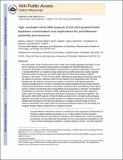| dc.contributor.author | Bayro, Marvin J. | |
| dc.contributor.author | Griffin, Robert Guy | |
| dc.contributor.author | Maly, Thorsten | |
| dc.contributor.author | Birkett, Neil R. | |
| dc.contributor.author | Dobson, Christopher M. | |
| dc.contributor.author | MacPhee, Cait E. | |
| dc.date.accessioned | 2012-08-07T19:14:23Z | |
| dc.date.available | 2012-08-07T19:14:23Z | |
| dc.date.issued | 2010-07 | |
| dc.date.submitted | 2010-07 | |
| dc.identifier.issn | 0006-2960 | |
| dc.identifier.issn | 1520-4995 | |
| dc.identifier.uri | http://hdl.handle.net/1721.1/72021 | |
| dc.description.abstract | The SH3 domain of the PI3 kinase (PI3-SH3 or PI3K-SH3) readily aggregates into fibrils in vitro and has served as an important model system in the investigation of the molecular properties and mechanism of formation of amyloid fibrils. We describe the molecular conformation of PI3-SH3 in amyloid fibril form as revealed by magic-angle spinning (MAS) solid-state nuclear magnetic resonance (NMR) spectroscopy. The MAS NMR spectra of these fibrils display excellent resolution, with narrow [superscript 13]C and [superscript 15]N line widths, representing a high degree of structural order and the absence of extensive molecular motion for the majority of the polypeptide chain. We have identified the spin systems of 82 of the 86 residues in the protein and obtained sequential resonance assignments for 75 of them. Chemical shift analysis indicates that the protein subunits making up the fibril adopt a compact conformation consisting of four well-defined β-sheet regions and four random-coil elements with varying degrees of local dynamics or disorder. The backbone conformation of PI3-SH3 in fibril form differs significantly from that of the native state of the protein, both in secondary structure and in the location of dynamic or disordered segments. The site-specific MAS NMR analysis of PI3-SH3 fibrils we report here is compared with previously published mechanistic and structural data, resulting in a detailed interpretation of the factors that mediate fibril formation by PI3-SH3 and allowing us to propose a possible model of the core structure of the fibrils. Our results confirm the structural similarities between PI3-SH3 fibrils | en_US |
| dc.description.sponsorship | National Institutes of Health (U.S.) (grant no. EB-003151) | en_US |
| dc.description.sponsorship | National Institutes of Health (U.S.) (grant no. EB-002026) | en_US |
| dc.language.iso | en_US | |
| dc.publisher | American Chemical Society (ACS) | en_US |
| dc.relation.isversionof | http://dx.doi.org/10.1021/bi100864t | en_US |
| dc.rights | Article is made available in accordance with the publisher's policy and may be subject to US copyright law. Please refer to the publisher's site for terms of use. | en_US |
| dc.source | PMC | en_US |
| dc.title | High-resolution MAS NMR analysis of PI3-SH3 amyloid fibrils: Backbone conformation and implications for protofilament assembly and structure | en_US |
| dc.type | Article | en_US |
| dc.identifier.citation | Bayro, Marvin J. et al. “High-Resolution MAS NMR Analysis of PI3-SH3 Amyloid Fibrils: Backbone Conformation and Implications for Protofilament Assembly and Structure,” Biochemistry 49.35 (2010): 7474–7484. | en_US |
| dc.contributor.department | Massachusetts Institute of Technology. Department of Chemistry | en_US |
| dc.contributor.department | Francis Bitter Magnet Laboratory (Massachusetts Institute of Technology) | en_US |
| dc.contributor.approver | Griffin, Robert Guy | |
| dc.contributor.mitauthor | Bayro, Marvin J. | |
| dc.contributor.mitauthor | Griffin, Robert Guy | |
| dc.contributor.mitauthor | Maly, Thorsten | |
| dc.relation.journal | Biochemistry | en_US |
| dc.eprint.version | Author's final manuscript | en_US |
| dc.type.uri | http://purl.org/eprint/type/JournalArticle | en_US |
| eprint.status | http://purl.org/eprint/status/PeerReviewed | en_US |
| dspace.orderedauthors | Bayro, Marvin J.; Maly, Thorsten; Birkett, Neil R.; MacPhee, Cait E.; Dobson, Christopher M.; Griffin, Robert G. | en |
| dc.identifier.orcid | https://orcid.org/0000-0003-1589-832X | |
| mit.license | PUBLISHER_POLICY | en_US |
| mit.metadata.status | Complete | |
